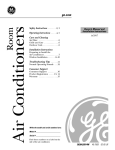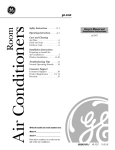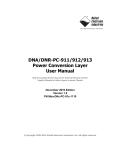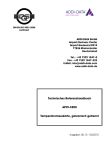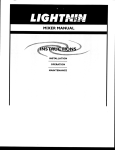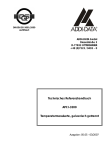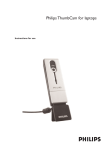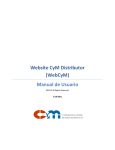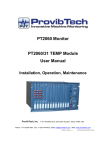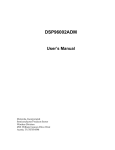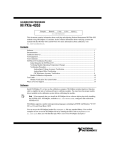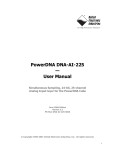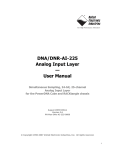Download DNA-STP-AI-U Product Manual - United Electronic Industries
Transcript
27 Renmar Avenue Walpole, MA 02081 Web site: www.ueidaq.com E-mail: [email protected] Tel: 508-921-4600 FAX: 508-668-2350 PowerDNA STP-AI-U Universal Analog Input Screw Terminal Panel — User Manual November 2007 Edition PN Man-DNA-STP-AI-U-1107 Version 1.5 © Copyright 1998-2007 United Electronic Industries, Inc. All rights reserved. DNA-STP-AI-U User Manual No part of this publication may be reproduced, stored in a retrieval system, or transmitted, in any form by any means, electronic, mechanical, by photocopying, recording, or otherwise without prior written permission. Information furnished in this manual is believed to be accurate and reliable. However, no responsibility is assumed for its use, or for any infringement of patents or other rights of third parties that may result from its use. All product names listed are trademarks or trade names of their respective companies. See the UEI website for complete terms and conditions of sale: http://www.ueidaq.com/company/terms.aspx Contacting United Electronic Industries Mailing Address: 27 Renmar Avenue Walpole, MA 02081 U.S.A. For a list of our distributors and partners in the US and around the world, please see http://www.ueidaq.com/partners/ Support: Telephone: Fax: (508) 921-4600 (508) 668-2350 Also see the FAQs and online “Live Help” feature on our web site. Internet Support: Support: Web-Site: FTP Site: [email protected] www.ueidaq.com ftp://ftp.ueidaq.com Product Disclaimer: WARNING! DO NOT USE PRODUCTS SOLD BY UNITED ELECTRONIC INDUSTRIES, INC. AS CRITICAL COMPONENTS IN LIFE SUPPORT DEVICES OR SYSTEMS. Products sold by United Electronic Industries, Inc. are not authorized for use as critical components in life support devices or systems. A critical component is any component of a life support device or system whose failure to perform can be reasonably expected to cause the failure of the life support device or system, or to affect its safety or effectiveness. Any attempt to purchase any United Electronic Industries, Inc. product for that purpose is null and void and United Electronic Industries Inc. accepts no liability whatsoever in contract, tort, or otherwise whether or not resulting from our or our employees' negligence or failure to detect an improper purchase. ii iii Table of Contents Chapter 1 Connecting the STP to your Layer . . . . . . . . . . . . . . . . . . . . . . . . . . . . . . . . . . 1 1.1 Installing a Cable for a DNA-AI-225 . . . . . . . . . . . . . . . . . . . . . . . . . . . . . . . . . . . . . . 1 1.2 Installing a Cable for a DNA-AI-207 . . . . . . . . . . . . . . . . . . . . . . . . . . . . . . . . . . . . . . 2 1.3 Connecting Power to Connectors . . . . . . . . . . . . . . . . . . . . . . . . . . . . . . . . . . . . . . . . 2 Chapter 2 Connecting Analog Inputs to the STP . . . . . . . . . . . . . . . . . . . . . . . . . . . . . . . 4 2.1 Overview . . . . . . . . . . . . . . . . . . . . . . . . . . . . . . . . . . . . . . . . . . . . . . . . . . . . . . . . . . . 4 2.2 Connecting Thermocouples . . . . . . . . . . . . . . . . . . . . . . . . . . . . . . . . . . . . . . . . . . . . 4 2.3 Enabling the CJC Feature. . . . . . . . . . . . . . . . . . . . . . . . . . . . . . . . . . . . . . . . . . . . . . 4 2.4 2.4.1 2.4.2 Connecting Voltage Inputs . . . . . . . . . . . . . . . . . . . . . . . . . . . . . . . . . . . . . . . . . . . . . 7 Enabling Filters . . . . . . . . . . . . . . . . . . . . . . . . . . . . . . . . . . . . . . . . . . . . . . . . 7 Enabling Return to Ground Through Resistor . . . . . . . . . . . . . . . . . . . . . . . . . 7 2.5 Connecting RTDs (+5V Excitation) . . . . . . . . . . . . . . . . . . . . . . . . . . . . . . . . . . . . . . . 7 2.6 Converting an RTD Voltage Signal to Temperature – 2-Wire. . . . . . . . . . . . . . . . . . . 8 2.7 Converting an RTD Voltage Signal to Temperature – 4-Wire. . . . . . . . . . . . . . . . . . 10 2.8 Jumper Settings Table . . . . . . . . . . . . . . . . . . . . . . . . . . . . . . . . . . . . . . . . . . . . . . . 12 Appendix A — Thermocouple Measurement Using an AI-225/AI-207. . . . . . . . . . . . . . . . 13 Index . . . . . . . . . . . . . . . . . . . . . . . . . . . . . . . . . . . . . . . . . . . . . . . . . . . . . . . . . . . . . . . . . . 17 © Copyright 2007 United Electronic Industries, Inc. Tel: 508-921-4600 Date: 11. 07. 2007 Vers: 1.5 File:dna-stp-ai-u UserManualTOC.fm iv List of Figures Chapter 1 Connecting the STP to your Layer . . . . . . . . . . . . . . . . . . . . . . . . . . . . . . . . . . 1 1-1 Connecting Your Layer to STP-AI-U Panel.................................................................... 1 1-2 Location of Jumpers/Connectors on STP-AI-U Panel.................................................... 3 Chapter 2 Connecting Analog Inputs to the STP . . . . . . . . . . . . . . . . . . . . . . . . . . . . . . . 4 2-1 Block Diagram of DNA-STP-AI-U Panel ........................................................................ 5 2-2 Location of Jumpers and Terminals on STP Panel........................................................ 6 2-3 Two-wire RTD Circuit..................................................................................................... 8 2-4 Four-wire RTD Circuit .................................................................................................. 10 © © Copyright Copyright 2007 2007 United United Electronic Electronic Industies, Industries,Inc. Inc. Tel: 508-921-4600 Date:11. 07. 2007 Date: 11. 07. 2007 Vers: Vers: 1.5 1.0 File:dna-stp-ai-u File:dna-stp-ai-uUserManualLOF.fm UserManualLOF.fm DNA-STP-AI-U Universal Terminal Panel Chapter 1 Connecting the STP to your Layer Chapter 1 1.1 Connecting the STP to your Layer Installing a Cable for a DNA-AI-225 This chapter defines the recommended procedure for connecting the STP-AI-U panel to your PowerDNA Layer board. Refer to Figure 2-1 for connector location and proceed as follows: STEP 1: Select a cable for connecting the STP-AI-U panel to your PowerDNA Layer. If you have a DNA-AI-225 Layer, use a DNA-CBL-62 2.5-ft, 62-conductor round cable with 62-pin male connectors on both ends. STEP 2: Plug one end into the DNA-AI-225 Layer DB-62 connector on the front of the PowerDNA Cube. STEP 3: Plug the other end of the cable into the connector on the STP-AI-U panel marked J225. DO NOT CONNECT ANY OTHER CABLES TO THE STP BOARD. Connect cables between these connectors or DNA-CBL-37 Cable (Use with AI-207) DNA-CBL-62 Cable (Use only with AI-225) Figure 1-1 Connecting Your Layer to STP-AI-U Panel © Copyright Copyright2006 2007 all rights reserved d ©Electronic Industries, Inc. United UnitedElectronic ElectronicIndustries, Industries,Inc. Inc. 81-821-2890 Tel: 508-921-4600 www.ueidaq.com Date: 11. 11.07. 07.2007 Printed 2007 11. 07. 2007 Vers: Vers: 1.50.5 1.0 File: File:stp-ai-u stp-ai-u ManualChap1.fm Fax: ManualChap1.fm 781-821-2891 1 DNA-STP-AI-U Universal Terminal Panel Chapter 1 Connecting the STP to your Layer 1.2 Installing a Cable for a DNA-AI-207 Refer to Figure 1-2 for connector location and proceed as follows: STEP 1: Select a cable for connecting the STP-AI-U panel to your PowerDNA Layer. If you have a DNA-AI-207 Layer, use a DNA-CBL-37 3-ft., 37-conductor flat ribbon cable with 37-pin connectors (one male and one female). STEP 2: Plug one end into the DNA-AI-207 Layer DB-37 connector on the front of the PowerDNA Cube. STEP 3: Plug the other end of the cable into the connector on the STP-AI-U panel marked J207. DO NOT CONNECT ANY OTHER CABLES TO THE STP BOARD. 1.3 Connecting Power to Connectors Connecting power to the connector used for your Layer requires you to install one or more jumpers, as follows: STEP 1: Refer to Figure 1-2 for location of jumpers. STEP 2: If you are using a DNA-AI-225 Layer, install a jumper in JPOW1 between Terminals 2 and 3. Install a second jumper in JPOW2 between Terminals 2 and 3. Do not install any jumper in JPOW3. STEP 3: If you are using a DNA-AI-207 Layer, install a jumper in JPOW1 between Terminals 2 and 3. Install a second jumper in JPOW2 between Terminals 1 and 2. Install a jumper in JPOW3 between terminals 1 and 2 (ON). Figure 1-2 shows the locations of various jumpers on the STP-AI-U panel board. (Refer to Table 2-2 on page 12 for a summary of all jumper settings.) © Copyright Copyright2006 2007 all rights reserved d ©Electronic Industries, Inc. United UnitedElectronic ElectronicIndustries, Industries,Inc. Inc. 81-821-2890 Tel: 508-921-4600 www.ueidaq.com Date: 11. 11.07. 07.2007 Printed 2007 11. 07. 2007 Vers: Vers: 1.50.5 1.0 File: File:stp-ai-u stp-ai-u ManualChap1.fm Fax: ManualChap1.fm 781-821-2891 2 DNA-STP-AI-U Universal Terminal Panel Chapter 1 Connecting the STP to your Layer JPOW3 J225 Connector JPOW2 J201 JPOW1 Connector (Legacy) J207 Connector Figure 1-2 Location of Jumpers/Connectors on STP-AI-U Panel © Copyright Copyright2006 2007 all rights reserved d ©Electronic Industries, Inc. United UnitedElectronic ElectronicIndustries, Industries,Inc. Inc. 81-821-2890 Tel: 508-921-4600 www.ueidaq.com Date: 11. 11.07. 07.2007 Printed 2007 11. 07. 2007 Vers: Vers: 1.50.5 1.0 File: File:stp-ai-u stp-ai-u ManualChap1.fm Fax: ManualChap1.fm 781-821-2891 3 DNA-STP-AI-U Universal Terminal Panel Chapter 2 Connecting Analog Inputs to the STP Chapter 2 2.1 2.2 Overview Connecting Thermocouples Connecting Analog Inputs to the STP This chapter describes the procedures necessary to do the following: • Connect analog inputs of various types to the STP-AI-U panel. • Insert jumpers on the board to configure the inputs and options for the types of input signals you are working with. (Refer to Table 2-2 on page 12.) • Define the linearization needed with an RTD input to convert analog voltage input to temperature. To connect thermocouple inputs, do the following: STEP 1: Connect each thermocouple signal line to the corresponding AINx Sig terminal on TB1 or TB2. Connect each thermocouple return line to the corresponding AINx Ret terminal on TB1 or TB2. Refer to Figure 2-2 for location of TB1, TB2, and screw terminals. STEP 2: To enable open thermocouple detection and low pass filter to ground, insert a jumper on JDx, where x is the channel number for that thermocouple. This action connects the signal line of the x channel to the open thermocouple detector circuit and a filter to ground. The location of JDx jumper terminals is noted in Figure 2-2. NOTE: For every thermocouple return line, you should also enable a return to ground through a filter (jumper JGx), through a 10k resistor (Jumper Nx), or both. It is sufficient, however, to insert just the Nx jumper because of the wide difference in resistor values. Inserting both Nx and JGx jumpers is not necessary, but inserting both will not cause an error. The location of all jumper terminals is shown in Figure 2-2. (Refer to Table 2-2 on page 12 for a summary of all jumper settings.) 2.3 Enabling the CJC Feature To enable cold junction compensation (CJC) for use with thermocouples, do the following: STEP 1: Install jumpers on JTC1 and JTC2, as indicated in Figure 2-2. This connects the CJC sensor to AIn 24 Sig and Ret lines. STEP 2: Install jumpers on JD24, N24, and JG24, as indicated in Figure 2-2. The JD24 jumper connects the Open TC detection/low pass filter feature to the AIn24 Sig line. The JG24 jumper connects a 10 megohm resistor and low pass filter to ground on the AIn24 Ret line. The N24 jumper connects a 10 kohm resistor to ground to the AIn24 Return line. Figure 2-1 is a block diagram of the STP-AI-U panel. Refer to this figure to see the function of each jumper. (Refer to Table 2-2 on page 12 for a summary of all jumper settings.) Copyright 2006 2007 all rights reserved d ©© Electronic Industries, Inc. United Electronic Industries, Inc. 81-821-2890 Tel: 508-921-4600 www.ueidaq.com Date: Date: 11. 11.07. 07.2007 Printed 2007 11. 07. 2007 Vers: Vers:1.5 0.5 1.0 File: File:stp-ai-u stp-ai-uManualChap2.fm Fax: ManualChap2.fm 781-821-2891 4 !'%",!.*, JTC1 CJC Sensor JTC2 J207/208 J201/202 J225 DIn1 DIn0 3 21 JPOW1 21 20 1 2 JPOW3 22 AIn24 Ret N JG AIn Sig P JD AIn Ret #$ Sig JPOW2 3 DIn2 8 2 JD #$ Ret 31 Analog Input Signals/Returns DIn3 26 P Ret AIn24 Sig N JG 3 ' #*#+!"&# 1:101 )#( #+ AIn 1 Sig !'%",!.*, AIn 5V Reference +VCC -VCC/AGND DIO_0 DIO_1 DIO_2 +5VRef DNA-STP-AI-U Universal Terminal Panel Chapter 2 Connecting Analog Inputs to the STP Typical Jumper Terminals (x is channel ID number) Refer to Figure 2-2 for location on board. Figure 2-1 Block Diagram of DNA-STP-AI-U Panel Figure 2-2 shows the locations of jumpers and terminals on the STP board. Copyright 2006 2007 all rights reserved d ©© Electronic Industries, Inc. United Electronic Industries, Inc. 81-821-2890 Tel: 508-921-4600 www.ueidaq.com Date: Date: 11. 11.07. 07.2007 Printed 2007 11. 07. 2007 Vers: Vers:1.5 0.5 1.0 File: File:stp-ai-u stp-ai-uManualChap2.fm Fax: ManualChap2.fm 781-821-2891 5 DNA-STP-AI-U Universal Terminal Panel Chapter 2 Connecting Analog Inputs to the STP Px jumpers Nx jumpers N24 JTC2 JG24 JD24 (alternates in reverse order down to JG16) JDx jumpers JGx jumpers (alternating up to JG15) JTC1 CJC Channel TB1 (screw terminal block) TB2 (screw terminal block) Figure 2-2 Location of Jumpers and Terminals on STP Panel Copyright 2006 2007 all rights reserved d ©© Electronic Industries, Inc. United Electronic Industries, Inc. 81-821-2890 Tel: 508-921-4600 www.ueidaq.com Date: Date: 11. 11.07. 07.2007 Printed 2007 11. 07. 2007 Vers: Vers:1.5 0.5 1.0 File: File:stp-ai-u stp-ai-uManualChap2.fm Fax: ManualChap2.fm 781-821-2891 6 DNA-STP-AI-U Universal Terminal Panel Chapter 2 Connecting Analog Inputs to the STP 2.4 Connecting To connect voltage (or millivolt) inputs to the STP, do the following: Voltage Inputs STEP 1: Connect each voltage input signal line to a terminal onTB1 or TB2 marked AInx Sig, where x is the channel number. STEP 2: Connect each voltage input return line to a terminal onTB1 or TB2 marked AInx Ret, where x is the channel number. 2.4.1 Enabling Filters To enable return to ground through a 10 megohm resistor/low pass filter circuit, insert jumpers in JGx for each selected channel, where x is the channel number. The location of JGx jumper terminals is noted in Figure 2-2. 2.4.2 Enabling Return to Ground Through Resistor To enable a ground return through a 10 kohm resistor on each voltage input, insert a jumper on Nx, where x is the channel number. This action connects the return line of the x channel input to ground through a 10kOhm resistor. The location of Nx jumper terminals is noted in Figure 2-2. 2.5 Connecting RTDs (+5V Excitation) To connect +5VRef excitation to RTD inputs, do the following: STEP 1: For every RTD input to which you want to connect internal +5V excitation, insert a jumper in Px, where x is the channel number of the signal line of the RTD input. The location of Px jumper terminals is noted in Figure 2-2. NOTE: If you use an external voltage or current excitation source, do not insert any jumpers in Px, where x is the channel number. Instead, connect your external source directly to the AInx Sig terminals on TB1 or TB2. STEP 2: Connect the screw terminal ”RET” to an “AGND” terminal. Copyright 2006 2007 all rights reserved d ©© Electronic Industries, Inc. United Electronic Industries, Inc. 81-821-2890 Tel: 508-921-4600 www.ueidaq.com Date: Date: 11. 11.07. 07.2007 Printed 2007 11. 07. 2007 Vers: Vers:1.5 0.5 1.0 File: File:stp-ai-u stp-ai-uManualChap2.fm Fax: ManualChap2.fm 781-821-2891 7 DNA-STP-AI-U Universal Terminal Panel Chapter 2 Connecting Analog Inputs to the STP 2.6 Converting an RTD Voltage Signal to Temperature – 2-Wire The following calculations may be used as a tool for converting the voltage signal measured across an RTD to temperature in Celsius. The basic measuring circuit for a 2-wire RTD temperature detector is shown in Figure 2-3. (+5V Ref) Vr Rs (20k) Px jumper 22.1ohm SIG R22.1 A/D Vm Vu Ru (RTD) RET Nx (open) AGND 10k Figure 2-3 Two-wire RTD Circuit Note that RET is connected directly to AGND. Referring to Figure 2-3, the calculation (at 0°C) is as follows: Temperature = 0 °C Ru = unknown resistance (RTD) Vr = 5VDC reference voltage Vm= input voltage to A/D converter ( R 22.1 + R s ) ⋅ V m – R 22.1 V r R u = -----------------------------------------------------------------Vr – Vm Using the values listed above, the the value of Ru is: 20022.1 × 0.0303399 ) – 22.1 ( 5 ) = 100ohms R u = (-------------------------------------------------------------------------------5 – 0.0303399 Copyright 2006 2007 all rights reserved d ©© Electronic Industries, Inc. United Electronic Industries, Inc. 81-821-2890 Tel: 508-921-4600 www.ueidaq.com Date: Date: 11. 11.07. 07.2007 Printed 2007 11. 07. 2007 Vers: Vers:1.5 0.5 1.0 File: File:stp-ai-u stp-ai-uManualChap2.fm Fax: ManualChap2.fm 781-821-2891 8 DNA-STP-AI-U Universal Terminal Panel Chapter 2 Connecting Analog Inputs to the STP Using a standard DIN 100 ohm Pt RTD with an alpha of 0.00385 ohms/°C yields the values shown in Table 2-1. Temperature °C Ru Vm V22.1 Vu Ohms mV mV mV CURRENT mA -200 18.52 10.134 5.5739 4.6204 .24950 -100 60.25 20.503 5.5025 14.990 .24879 0 100.0 30.339 5.4914 24.848 .24848 100 138.50 39.831 5.4808 34.348 .24800 200 175.86 49.005 5.4709 43.5341 .24755 300 212.05 57.861 5.4611 52.3997 .24711 400 247.09 65.902 5.4494 60.9275 .24658 500 280.98 74.639 5.4427 69.1997 .24628 Table 2-1 Vin vs. RTD Resistance at Various Temperatures Copyright 2006 2007 all rights reserved d ©© Electronic Industries, Inc. United Electronic Industries, Inc. 81-821-2890 Tel: 508-921-4600 www.ueidaq.com Date: Date: 11. 11.07. 07.2007 Printed 2007 11. 07. 2007 Vers: Vers:1.5 0.5 1.0 File: File:stp-ai-u stp-ai-uManualChap2.fm Fax: ManualChap2.fm 781-821-2891 9 DNA-STP-AI-U Universal Terminal Panel Chapter 2 Connecting Analog Inputs to the STP 2.7 Converting an RTD Voltage Signal to Temperature – 4-Wire The calculations in this section may be used as a tool for converting the voltage signal measured across an RTD to temperature in Celsius. The basic measuring circuit for a 4-wire RTD temperature detector is shown in Figure 2-4. (+5V Ref) Vr Rs (20k) Px jumper (installed) 22.1ohm SIG NOTE: Chx is used only to supply and read the excitation voltage for the RTD. R22.1 A/D Vu Ru (RTD) Chx RET AGND Nx (open) AGND (+5V Ref) Vr Rs (20k) Px jumper (open) 22.1ohm SIG NOTE: Chy is used to measure voltage across the RTD itself.. A/D Chy R22.1 Vm RET Nx (open) 10k Figure 2-4 Four-wire RTD Circuit Copyright 2006 2007 all rights reserved d ©© Electronic Industries, Inc. United Electronic Industries, Inc. 81-821-2890 Tel: 508-921-4600 www.ueidaq.com Date: Date: 11. 11.07. 07.2007 Printed 2007 11. 07. 2007 Vers: Vers:1.5 0.5 1.0 File: File:stp-ai-u stp-ai-uManualChap2.fm Fax: ManualChap2.fm 781-821-2891 10 DNA-STP-AI-U Universal Terminal Panel Chapter 2 Connecting Analog Inputs to the STP As shown in the diagram, Channel x supplies and reads the excitation voltage for the 4-wire RTD circuit. Channel y reads the voltage across the RTD itself. Also note that RET is connected to AGND. The calculation for determining the RTD resistance for Channel y is: ( R s + R 22.1 ) ⋅ V m Ru = ----------------------------------------Vr – Vm The table below lists the calculation results at various temperatures. Copyright 2006 2007 all rights reserved d ©© Electronic Industries, Inc. United Electronic Industries, Inc. 81-821-2890 Temperature °C Ohms -200 18.52 4.62376 -100 60.31 15.04219 0 100.00 24.96663 100 138.50 34.57883 200 175.86 43.90573 300 212.05 52.94103 400 247.09 61.68922 500 280.98 70.15030 Tel: 508-921-4600 www.ueidaq.com Date: Date: 11. 11.07. 07.2007 Printed 2007 11. 07. 2007 Ru Vm mV Vers: Vers:1.5 0.5 1.0 File: File:stp-ai-u stp-ai-uManualChap2.fm Fax: ManualChap2.fm 781-821-2891 11 DNA-STP-AI-U Universal Terminal Panel Chapter 2 Connecting Analog Inputs to the STP 2.8 Jumper Table 2-2 summarizes the jumper settings required for selection of options for Settings Table each layer type and function. Layer Type Sensor Type Function Jumper ID Terminals Connected DNA-AI-207 Thermocouples Power JPOW1 2-3 JPOW2 1-2 JPOW3 1-2 JTC1 ON JTC2 ON JD24 ON N24 ON JG24 ON JDX ON JGx -- Nx ON 10k Return to GND Nx ON 1 MΩ + Filter to GND JGx -- +5V Internal Excit. Px ON User-supplied Extern Excitation Px Open Power JPOW1 2-3 JPOW2 2-3 JPOW3 Open JTC1 ON JTC2 ON JD24 ON N24 ON JG24 ON JDX ON JGx -- Nx ON 10k Return to GND Nx ON 1 MΩ + Filter to GND JGx -- +5V Int Exc. Px ON User-supplied External Excitation Px Open Enable CJC Open TC Detect. Voltage RTD DNA-AI-225 Thermocouples Enable CJC Open TC Detect. Voltage RTD Table 2-2 Jumper Settings Table Copyright 2006 2007 all rights reserved d ©© Electronic Industries, Inc. United Electronic Industries, Inc. 81-821-2890 Tel: 508-921-4600 www.ueidaq.com Date: Date: 11. 11.07. 07.2007 Printed 2007 11. 07. 2007 Vers: Vers:1.5 0.5 1.0 File: File:stp-ai-u stp-ai-uManualChap2.fm Fax: ManualChap2.fm 781-821-2891 12 DNA-STP-AI-U Universal Terminal Panel Appendix A Thermocouple Measurement Using an AI-225/AI-207 A thermocouple is a sensor used to measure temperature in a wide range of applications. Its ability to sense temperature is based on the so-called “Seebeck Effect”, discovered by Thomas Seebeck in 1821. The Seebeck Effect, also known as the thermoelectric effect, states that any electrical conductor will produce a voltage when subjected to a thermal gradient. The magnitude and polarity of the voltage produced varies with the type of metal used for the conductor and the magnitude and polarity of the thermal gradient. A thermocouple is constructed by connecting two conductors, composed of dissimilar metals, at both ends to form two junctions. Since the second conductor senses the same thermal gradient as the first, it also produces a voltage. This voltage, however, is different from that of the first conductor because it is made from a different metal. The small difference between the two voltages, which is typically in the millivolt range, is used for measurement of the thermal gradient. Since the voltage is generated by a thermal difference between the junctions, one junction is called the “hot junction” and the other is called the “cold junction” or “reference junction.” An increase in the temperature difference between hot and cold junctions increases the voltage generated in a non-linear relation. The degree of linearity is a property of the two metals used to make the thermocouple. Breaking the circuit to insert a voltmeter as shown in the diagram below illustrates how a thermocouple is typically used to measure temperature in an application. wire of metal A “hot” junction at point of temperature sensing “cold” junction at ambient temperature Metal C wire of metal B Metal C Isothermal Block T Voltmeter cold junction temperature measurement Cold Junction Compensation Theory Typically, a voltage is produced by a thermocouple at any given temperature. For example, the K-type thermocouple at 300°C will produce 12.2mV. To measure this voltage accurately, you must compensate for using any contact made to a thermocouple -- a technique called cold junction compensation (CJC). In case you are wondering why connecting a voltmeter to a thermocouple does not make several additional thermocouple junctions (leads connecting to the thermocouple, leads to the meter, inside the meter etc), the law of intermediate metals states that a third metal, inserted between the two dissimilar metals of a thermocouple junction will have no effect provided that the two junctions are at Copyright 2006 2007 all rights reserved d ©© Electronic Industries, Inc. United Electronic Industries, Inc. 81-821-2890 Tel: 508-921-4600 www.ueidaq.com Date: Date: 11. 11.07. 07.2007 Printed 2007 11. 07. 2007 Vers: Vers:1.5 0.5 1.0 File: File:dna-stp-ai-uAppA.fm dna-stp-ai-uAppA.fm Fax: 781-821-2891 13 DNA-STP-AI-U Universal Terminal Panel the same temperature. It is important to keep this in mind when we construct thermocouple junctions. Based on this law, it is quite acceptable to make a thermocouple junction by soldering the two metals together as the solder will not affect the reading. In practice, however, thermocouple junctions are made by welding the two metals together (usually by capacitive discharge) because this ensures that the performance is not limited by the melting point of solder. Cold Junction Compensation Using a PowerDNA Screw Terminal Panel (STP) Ambient temperature measurement is done by Cold Junction compensation (CJC). A PowerDNA Screw Terminal Panel has an isothermal metal block which is at ambient temperature. The voltage generated by the ambient temperature is measured using a dedicated CJC channel available in UEI Analog Input Layers. Software then determines the voltage created at the “cold” junction and subtracts this error voltage before linearizing the thermocouple input. Table A-1 describes the CJC channel number for various Analog Input Layers using a DNA-STP-AI-U or a DNA-AI-207TC Screw Terminal Panel. Note, however, that the STP-AI-207TC is not used with the AI-225 Layer. Table A-1. Layer CJC channel Number Comments AI-207 Channel 33 Single-Ended AI-225 Channel 24 Single-Ended Hardware Setup of Analog Input AI-225 and AI-207 Layers Analog Input AI-225 and AI-207 Layers have a dedicated CJC channel which measures voltage corresponding to the ambient temperature. The example below shows the hardware set to measure temperatures accurately using a thermocouple. The thermocouple input is connected to the one of the Analog Input channels and the CJC input is configured in software as per Table 1. AIn0 ADC Vtc CJC ADC Vcjc Vresult = Vtc + Vcjc Copyright 2006 2007 all rights reserved d ©© Electronic Industries, Inc. United Electronic Industries, Inc. 81-821-2890 Tel: 508-921-4600 www.ueidaq.com Date: Date: 11. 11.07. 07.2007 Printed 2007 11. 07. 2007 Vers: Vers:1.5 0.5 1.0 File: File:dna-stp-ai-uAppA.fm dna-stp-ai-uAppA.fm Fax: 781-821-2891 14 DNA-STP-AI-U Universal Terminal Panel Linearization Within the "usable" temperature range of any thermocouple, there is a proportional relationship between thermocouple voltage and temperature. This relationship, however, is by no means a linear relationship. In fact, most thermocouples are extremely non-linear over their operating ranges. To obtain temperature data from a thermocouple, it is necessary to convert the non-linear thermocouple voltage to temperature units. This process is called "linearization." Several methods are commonly used to linearize thermocouples. At the lowcost end of the solution spectrum, one can restrict the thermocouple operating range such that the thermocouple is nearly linear to within the measurement resolution. At the opposite end of the spectrum, special thermocouple interface components (integrated circuits or modules) are available to perform both linearization and reference junction compensation in the analog domain. In general, neither of these methods is well-suited for cost-effective, multipoint data acquisition systems. In addition to linearizing thermocouples in the analog domain, it is possible to perform such linearizations in the digital domain. This is accomplished by means of either piece-wise linear approximations (using look-up tables) or arithmetic approximations, or in some cases, a hybrid of these two methods. Software Implementation To do accurate temperature measurements, one has to read the channel where the thermocouple is connected, as well as a CJC channel. Feed these values to a NIST-derived polynomial formula to get an accurate thermocouple junction temperature. Code Snippet for the AI-225: To read the CJC channel, you must specify Channel 24 in single-ended mode in the channel list. The snippet of the code is shown below: for (i = 0; i < CHANNELS; i++) { cl[i] = i |DQ_LNCL_GAIN(DQ_AI225_GAIN_1) } DQ_LNCL_DIFF; } c1[CHANNELS] = 24 | DQ_LNCL_GAIN(DQ_AI225_GAIN_1); Code Snippet for the AI-207: To read the CJC channel, you must specify Channel 33 in single-ended mode in the channel list. The snippet of the code is shown below: for (i = 0; i < CHANNELS; i++) { cl[i] = i |DQ_LNCL_GAIN(DQ_AI207_GAIN_1) } DQ_LNCL_DIFF; } c1[CHANNELS] = 33 | DQ_LNCL_GAIN(DQ_AI207_GAIN_1); Open TC Detection: A DNA-STP-AI-U Screw Terminal Panel has the hardware implementation to detect an open TC. An Open TC will show high positive temperatures beyond the limits of the thermocouple range. Copyright 2006 2007 all rights reserved d ©© Electronic Industries, Inc. United Electronic Industries, Inc. 81-821-2890 Tel: 508-921-4600 www.ueidaq.com Date: Date: 11. 11.07. 07.2007 Printed 2007 11. 07. 2007 Vers: Vers:1.5 0.5 1.0 File: File:dna-stp-ai-uAppA.fm dna-stp-ai-uAppA.fm Fax: 781-821-2891 15 DNA-STP-AI-U Universal Terminal Panel References: Copyright 2006 2007 all rights reserved d ©© Electronic Industries, Inc. United Electronic Industries, Inc. 81-821-2890 • DNA-AI-225 User Manual • DNA-AI-207 User Manual • DNA-STP-AI-U User Manual Tel: 508-921-4600 www.ueidaq.com Date: Date: 11. 11.07. 07.2007 Printed 2007 11. 07. 2007 Vers: Vers:1.5 0.5 1.0 File: File:dna-stp-ai-uAppA.fm dna-stp-ai-uAppA.fm Fax: 781-821-2891 16 Index 17 Index Numerics 2-wire RTD 8 4-wire RTD 10 B Enabling open TC detection/low pass filters I Installing a Cable for a DNA-AI-207 2 Installing a Cable for a DNA-AI-225 1 Block Diagram of DNA-STP-AI-U Panel C 5 DNA-CBL-37 DNA-CBL-62 E J Jumper Location Connecting Power to Connectors 2 Connecting RTDs (+5V Excitation) 7 Connecting thermocouple inputs 4 Connecting voltage inputs 7 Converting an RTD voltage signal to temperature 8, 10 D 2 1 L 2 Location of Jumpers and Terminals on STP Panel 6 S Support ii Support email [email protected] Support FTP Site ftp ii //ftp.ueidaq.com ii Enabling cold junction compensation ©©Copyright Copyright2006 2007all rights reserved United UnitedElectronic ElectronicIndustries, Industries,Inc. Inc. 4 4 Tel: 508-921-4600 Date: Date: 11. 11.07. 07.2007 2007 Support Web Site www.ueidaq.com ii Vers: Vers: 1.5 1.0 File:dna-stp-ai-u File:dna-stp-ai-uUserManualIX.fm UserManu-






















